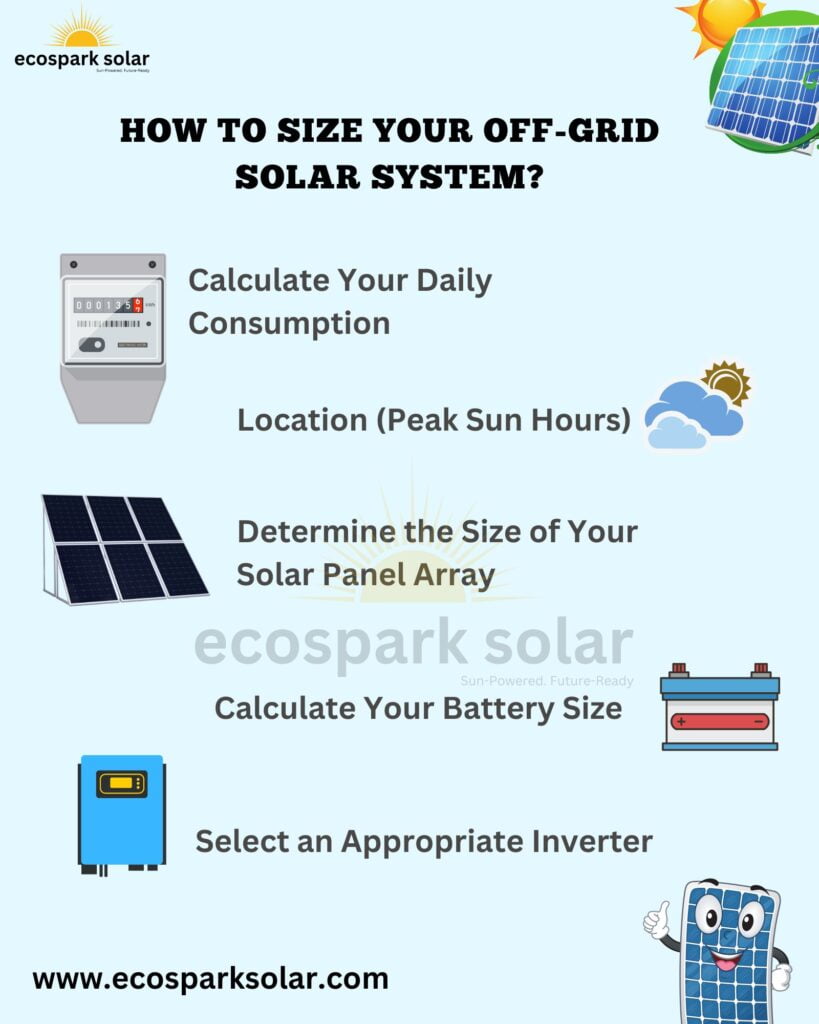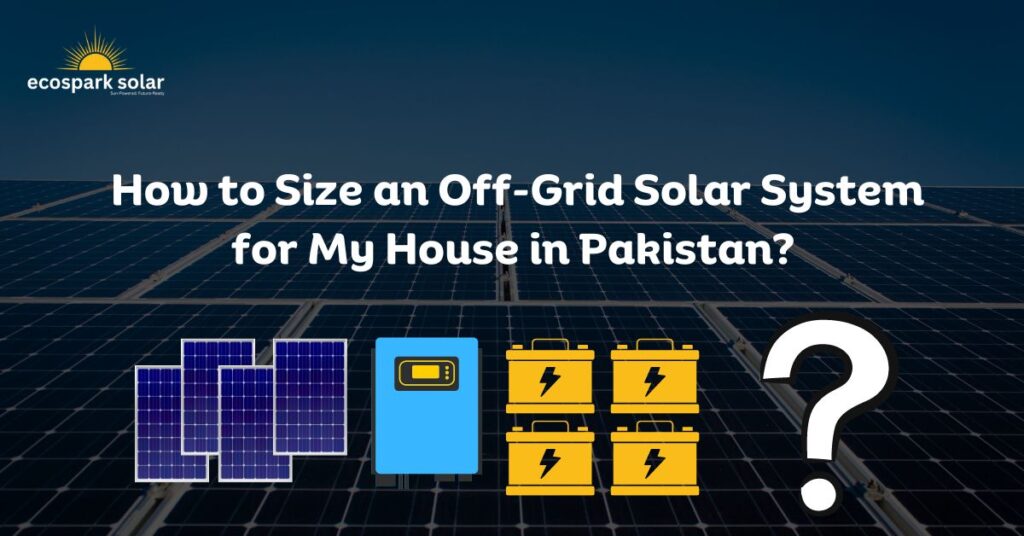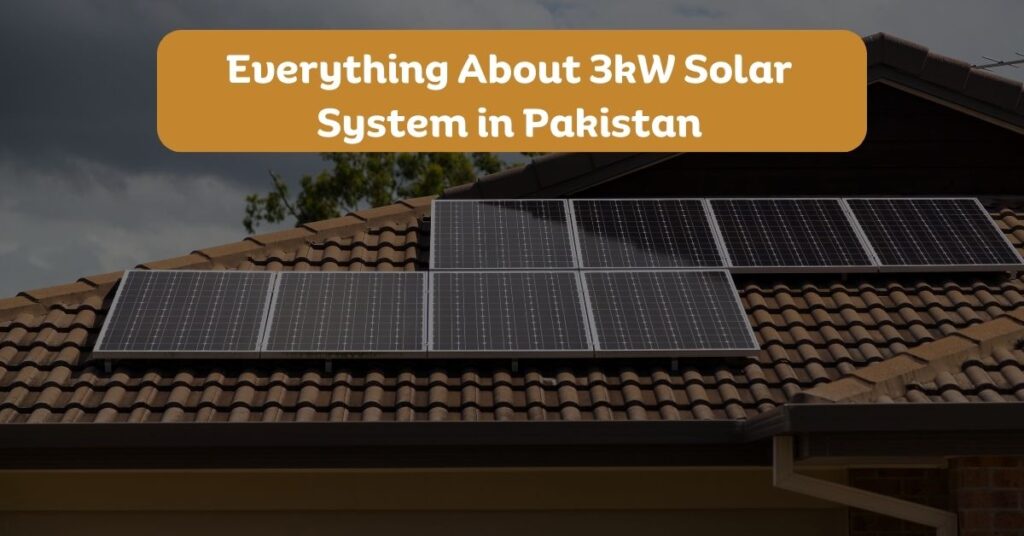Off-grid solar systems are designed to generate electricity solely from solar panels and store it in batteries for later use, particularly during periods of limited sunlight. These systems are perfect for homes and facilities in remote areas that lack a connection to the main power grid. Those who want complete independence from the grid can also consider going off-grid.
But off-grid is also for those who want to have a solar system like they earlier had UPS system. That is, have a couple of batteries connected to solar panels and WAPDA electricity. But not the grid, just the WAPDA electricity.
An off-grid solar setup includes key components such as solar panels, charge controllers, battery banks, and inverters. But what about sizing it? How to size an off-grid system for your home—or any other facility?
That’s what we will discuss in the lines below.
How to Size an Off-Grid System for My House?
We will divide this section into small steps to make it easy for you. We intend to simplify the process as much as possible—but if you still require any help, let us know, and we will gladly help you. Also, just to be clear, this article talks about sizing an off-grid system. If you want to know about sizing other types of solar systems, you may find the articles listed below helpful:
For off-grid system sizing, you may continue reading this article.
Step 1: Determine Your Energy Needs
The first step is calculating your energy requirements over a year, including the average daily energy consumption of your house—or business. It’s important to consider usage patterns to ensure the system’s capacity meets your needs. Identify and list all the devices and appliances you intend to power with your off-grid solar system. For example, the number of lights, refrigerators, well-pumps, air conditioners, fans, and any other electrical equipment.
The power required by each appliance is usually listed on the device. If not, you can use a power meter for precise and real-time consumption data.
The final output will be in watts (W) or kilowatts (kW). For the sake of simplicity, let’s say you have 15 lights, each one 10-watt and used for 8 hours a day. Add a refrigerator of 400 watts (could be less that 400W), used for 24 hours a day. Similarly, add the energy consumption of all the devices, and you will get a final output like this:
Total energy consumption per day: (15 x 10 x 8) + (400 x 24) = 1200 + 9600 = 10,800 watts or 10.8 kW
This is just an example—you can calculate your own for all the appliances (water pump, iron, fans, etc.), and the output will most likely be higher.
Step 2: Calculate Peak Sun Hours
Peak sun hours, also called solar irradiation, are those hours when solar panels will work at their best. The number of peak hours your roof is exposed to depends on geographical location. After establishing daily energy usage, the next step is to evaluate the solar radiation received by your property on a typical day.
Read our article about calculating peak sun hours. The article also lists solar irradiation in some Pakistani cities—if your city is not listed, you can get an idea from the solar resources map given there. For example, in Islamabad, the number of peak hours is 5.5.
Step 3: Size Your Off-Grid Solar Panel Capacity
The total capacity of solar panels is determined by calculating the energy output of a single solar panel.
Energy generated by one solar panel = solar panel capacity x peak sun hours x solar efficiency factor
For instance, if 500-watt solar panels are used in Islamabad, each panel would generate:
Energy generated by one 500W solar panel in Islamabad: 0.5kW x 5.5 hours x 0.8 = 2.2 kWh
With this information, you can assess how many panels are needed to cover your monthly consumption. However, real-world inefficiencies, aging, angle and direction, module soiling, and voltage drop must be factored in, possibly adding up to a 15% loss. This results in a higher required system size.
Considering batteries is essential as well. You need panels for generating power during the daytime and charging batteries for the nighttime. It means that you will need more panels.
For example, if one panel generates 2.2 kW per day, then it becomes 66 kWh per month. Suppose your monthly consumption is 600 units. It means you will need around 10 panels (600/66 ≈ 10)—or a 5kW solar system. For extra energy needed to charge the batteries, you will need additional solar panels. Also, this doesn’t factor in your peak power usage—taking that into account may increase your system size. 4 additional panels or 7kW solar system would work fine, I suppose.
You May Like to Know: How Much Does a 5kW Solar System Cost in Pakistan?
Step 4: Choosing Inverter Size
We are done with determining the capacity of our solar panels. Let’s move on to the next step—sizing your solar inverter.
When calculating the size of a solar inverter for an off-grid system, it is important to consider the total wattage of all the appliances and devices that the system will power. You will already have calculated that in the first step. But note that the inverter should be sized to handle the peak power requirements of all connected loads.
In ideal circumstances, the inverter chosen should match the capacity of your solar panels. For instance, a 5kW inverter for 5kW solar panels. But we always recommend going for a bit higher size, as inverters are not 100% efficient. There are also losses, which you will have to account for.
Secondly, inverters are designed to work at an optimal temperature, usually 25°C. If the temperatures increase, as usually does in Pakistan in summer, the performance of the inverter decreases, sometimes by more than 15%. A 5kW inverter designed for 25°C will give an output of 4 kW at 40°C. Keeping these factors in mind, always leave room for losses and decreases in performance.
There are some inverters that have 5kW capacity but can take the input PV load of 6000W panels. That can also work – just ensure that you choose a good inverter, as that won’t compromise on the performance.

A solar system for everyone.
We’re customer-centric; we will find you a solution within your budget. Whatever your project size, you can always save with Ecospark Solar.
Step 5: Choosing Battery Configuration
This is the last but most crucial step. Selecting the appropriate battery will ensure that your system can provide reliable power throughout the day and night.
To choose the correct battery size, you will have the following:
- Daily consumption (which you will already have calculated in the first step).
- Days of autonomy (meaning the number of days for batteries to provide power when the sun may not shine. We will keep it 5, but you can increase or decrease it.)
- Depth of discharge (this is the extent to which you can safely discharge a battery. For lead acid batteries, it is 50%; for lithium-ion batteries, it could be 80% or even more.)
Let’s assume you consume 10 kWh per day and want your batteries to last for five days without recharging.
The size will turn out to be (5 x 10)/0.5= 100kWh battery size.
We took lead acid batteries here, with 50% depth of discharge (DoD).
If you want to install lithium-ion, we will keep the DoD at 0.8. Let’s calculate the size for that.
(5 x 10)/0.8 = 62.5 kWh lithium-ion batteries.
You can convert kWh to Ah by dividing the kWh by the voltage of your system. This could be either 12, 24, or 48. If we keep it 24, then it will become 100,000 watts/24=4166 Ah for lead-acid and 6250/24=2604 Ah. So, around 13 lead-acid batteries. But this system would also run everything you have. If you do not want to keep everything running, you can reduce the number of batteries based on your needs.
That’s all about how to size an off-grid system for your home or business.
Related Read: Lead-Acid vs. Lithium-ion Solar Batteries: Which Battery is Best for Solar?
Recap: How to Size an Off-Grid System for My Home?
It’s simple. Calculate your daily energy consumption, including peak power usage. Then assess your peak sun hours—you can find them in our article listed above. Then determine the solar panel capacity, the formulae of which are already given. Based on this capacity, choose an appropriate inverter. Finally, determine the battery size, and you are good to go.
When all this is done, congratulations! You now need to install your off-grid solar system. If you need the services of a professional company, who can better serve you than our team at EcoSpark Solar? We bet no one! We are experts and customer-oriented—it is all about solar and you while working with us.



